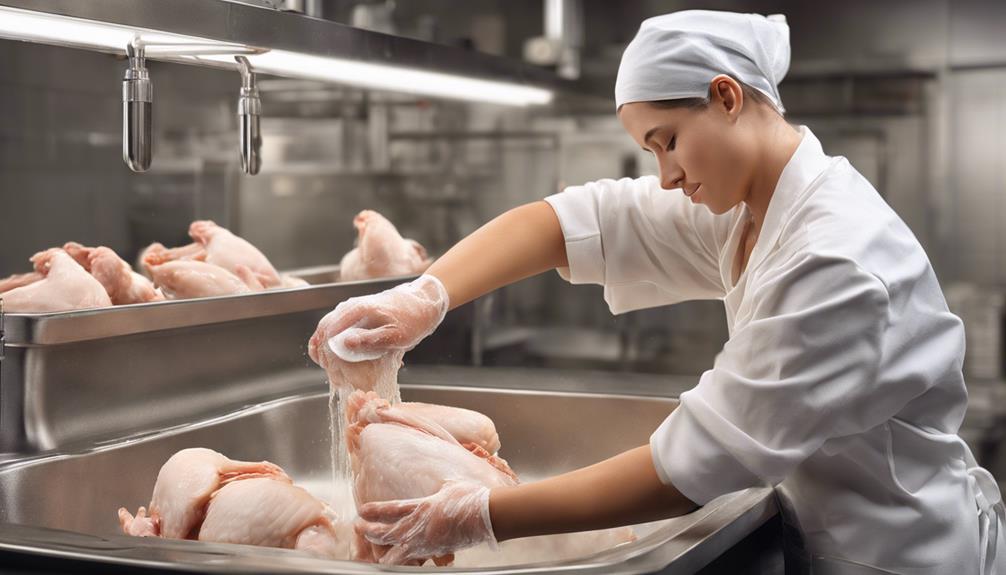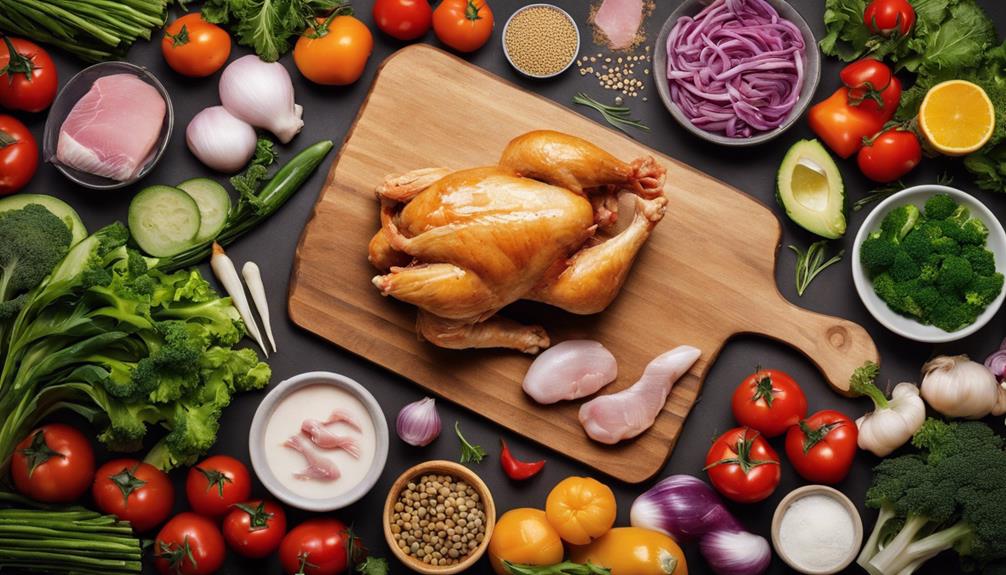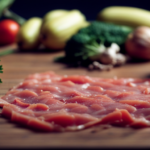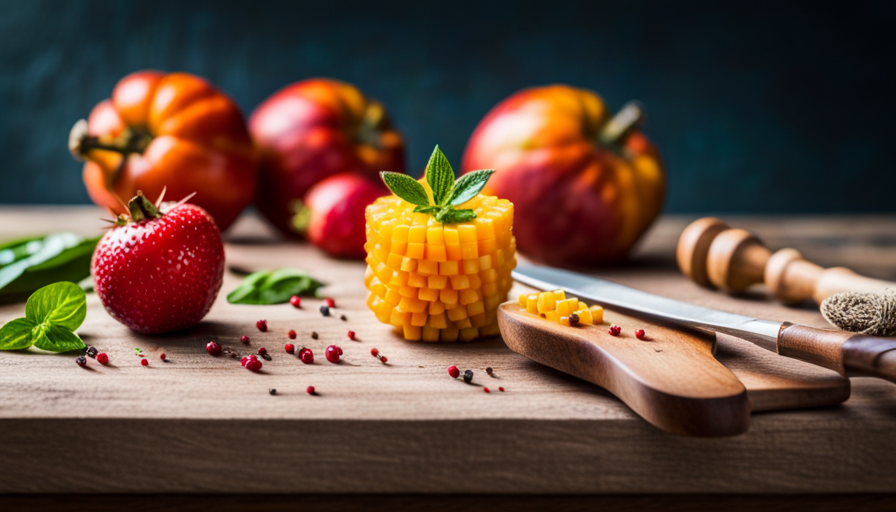After handling raw chicken, it is crucial to thoroughly wash hands with warm, soapy water for at least 20 seconds to eliminate harmful bacteria. Utensils should be washed with hot, soapy water, soaked in a bleach solution, or cleaned in a dishwasher with a sanitizing cycle. Surfaces that have been in contact with raw chicken must be cleaned with hot, soapy water to prevent cross-contamination. It is important to use separate cutting boards for raw chicken and other foods, as well as regularly sanitize tools. By following these steps diligently, you can ensure a safe kitchen environment for food workers and consumers of prepared meals.
Key Takeaways
- Wash hands thoroughly with warm, soapy water for at least 20 seconds.
- Clean and sanitize all utensils and surfaces that came into contact with raw chicken.
- Use designated cutting boards and utensils for raw chicken to prevent cross-contamination.
- Store leftover raw chicken in sealed containers in the refrigerator to maintain freshness.
- Promote frequent and proper handwashing practices among all food workers in the kitchen.
Handwashing Techniques
When handling raw chicken, it's important to wash your hands thoroughly with warm water and soap for at least 20 seconds to prevent bacterial contamination. The friction and scrubbing action help to make sure that all harmful bacteria are removed, especially under the nails and between fingers where they can hide.
Proper handwashing is vital when dealing with food, particularly raw meats, as it prevents the spread of any potential contaminants to other surfaces or foods in the kitchen environment. By taking the time to wash your hands correctly, you aren't only protecting yourself but also those who'll consume the meals you prepare.
Utensil Sanitization

Sanitizing utensils used for cutting raw chicken is essential to prevent cross-contamination and promote food safety in the kitchen. Here are some key steps to follow:
- Wash utensils with hot, soapy water after preparing raw chicken. This helps remove any remaining bacteria and residue from the cutting boards or knives.
- Utilize a dishwasher with a sanitizing cycle for an effective cleaning method. The high temperatures in the dishwasher can help kill any harmful bacteria present on the utensils.
- Soak utensils in a bleach solution (1 tablespoon of bleach per gallon of water) for at least 2 minutes. This provides an extra layer of disinfection to eliminate any potential pathogens that may be lingering on the utensils.
Surface Cleaning
To maintain a hygienic kitchen environment, it is essential to thoroughly clean all surfaces that have come in contact with raw chicken using hot, soapy water. Cleaning surfaces plays a vital role in preventing cross-contamination and ensuring the safety of your kitchen. Here is a simple guide to help you maintain a clean and bacteria-free kitchen environment:
| Cleaning Surfaces | Cross-Contamination |
|---|---|
| Use hot, soapy water to clean countertops, cutting boards, and utensils after contact with raw chicken. | Prevent the spread of harmful bacteria by sanitizing all surfaces that have been in contact with raw chicken. |
| Avoid using the same cloth or sponge for cleaning different surfaces to reduce the risk of cross-contamination. | Implement a regular cleaning routine using antibacterial products to eliminate any potential pathogens. |
Separate Cutting Boards
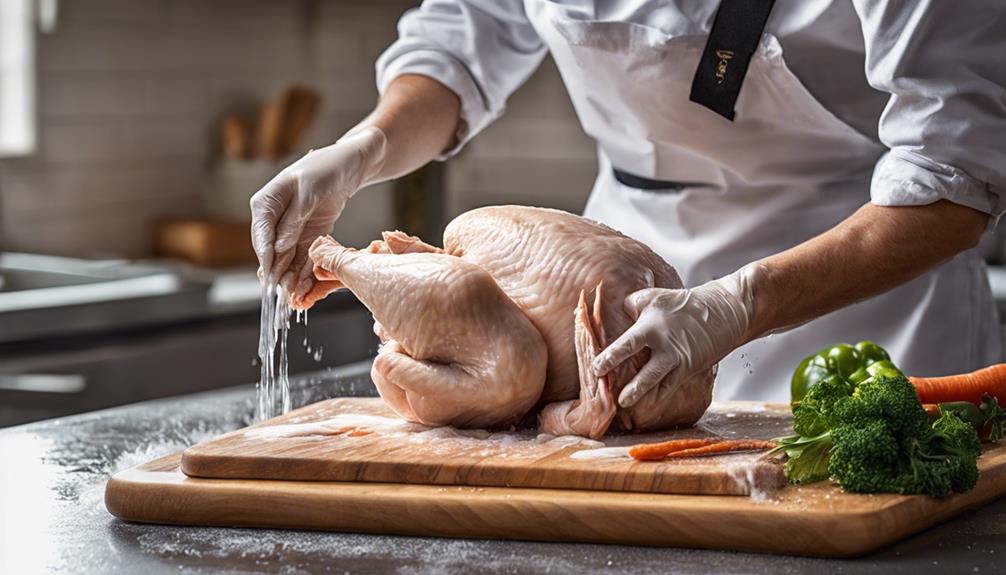
Using separate cutting boards for raw chicken is vital to prevent cross-contamination with other foods. When handling raw chicken, it's important to maintain strict hygiene practices to guarantee food safety. Here are some key points to keep in mind:
- Designate specific cutting boards: Always have a separate cutting board for fresh fruits, vegetables, and other ready-to-eat foods to avoid any contact with the one used for raw chicken. This simple step can greatly reduce the risk of spreading harmful bacteria.
- Color-code your cutting boards: Consider using color-coded cutting boards to differentiate between the board used for raw chicken and those used for other items. This visual cue can help remind you which board is safe for preparing different types of foods.
- Regularly clean and sanitize: After each use, wash the cutting board used for raw chicken with hot, soapy water to eliminate any lingering bacteria. Proper cleaning and sanitation practices are essential to maintaining a hygienic kitchen environment.
Dishwasher Sanitization
When sanitizing dishes in the dishwasher after handling raw chicken, remember to follow these steps:
- Choose appropriate heat settings
- Conduct regular maintenance checks
- Use approved detergents
These steps are crucial to ensure that dishes and utensils are thoroughly cleaned and free of any harmful bacteria.
Maintaining a sanitary dishwasher is a key element of food safety practices to prevent contamination and foodborne illnesses.
Proper Heat Settings
Ensuring proper sanitization of dishes, set the dishwasher to a high heat setting of at least 180°F after cutting raw chicken. Here are three key points to keep in mind:
- Effective Bacteria Elimination: High heat settings in the dishwasher help kill harmful bacteria, ensuring dishes are thoroughly sanitized.
- Preventing Cross-Contamination: The high heat setting is essential for preventing cross-contamination from raw chicken to other surfaces in the dishwasher.
- Food Safety Compliance: Proper dishwasher sanitization is vital for maintaining food safety standards in any kitchen environment, ensuring a clean and safe food preparation area.
Regular Maintenance Checks
Regularly checking and calibrating the dishwasher's temperature gauge is essential to guarantee effective sanitization after handling raw chicken.
A food thermometer is necessary to make sure the dishwasher reaches at least 180°F, killing any harmful bacteria that could cause foodborne illness.
By using chlorine-based sanitizers in the dishwasher, you can further eliminate any remaining bacteria from raw chicken.
Implementing a daily maintenance checklist will help monitor and document the dishwasher's upkeep, ensuring it functions properly.
It's important to train staff on the significance of maintaining proper dishwasher sanitization procedures to prevent cross-contamination.
Use Approved Detergents
To maintain a safe and hygienic kitchen environment after handling raw chicken, it's essential to utilize approved detergents for dishwasher sanitization.
- Choose the Right Detergent: Opt for detergents specifically approved for dishwashers to guarantee effective sanitization.
- Follow Manufacturer Guidelines: Adhere to the dishwasher manufacturer's instructions for the correct amount of detergent to use.
- Inspect Your Cutting Board: Before loading it into the dishwasher, check your cutting board for any leftover chicken residue to prevent cross-contamination.
Using approved detergents in your dishwasher is vital for eliminating harmful bacteria like Salmonella. By following these steps, you can help safeguard against foodborne illnesses and maintain a clean kitchen environment.
Bleach Solution Preparation
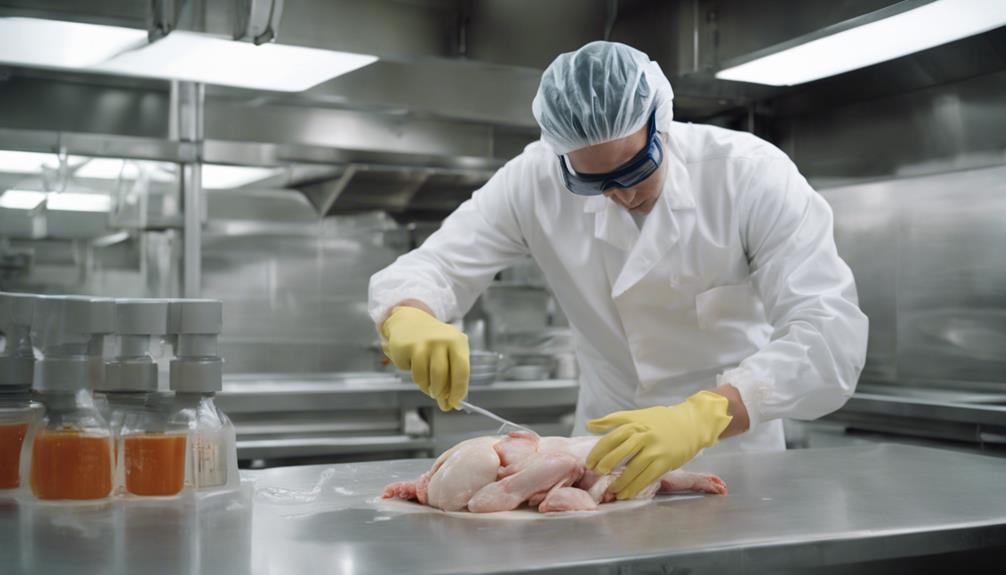
When preparing a bleach solution for sanitizing surfaces that have been in contact with raw chicken, mix 1 tablespoon of bleach with 1 gallon of water. This solution is effective in killing bacteria and maintaining a safe environment in the kitchen. After applying the bleach solution to the surfaces, allow it to sit for at least 5 minutes to guarantee proper sanitation.
It's important to rinse the surfaces thoroughly with clean water after using the bleach solution to remove any remaining residue. By following these steps, you can prevent cross-contamination and uphold a hygienic workspace.
I always make sure to have this bleach solution ready whenever I handle raw chicken to ensure that any surfaces that come in contact with it are properly sanitized. It gives me peace of mind knowing that I'm taking the necessary steps to guarantee the safety of the food I prepare and serve to others.
Tool and Equipment Sanitization

After handling raw chicken, it's crucial to sanitize cutting boards, knives, and other tools using hot, soapy water to eliminate harmful bacteria. Here are some key steps to guarantee proper tool and equipment sanitization:
- Hot Soapy Water: Thoroughly wash cutting boards, knives, and utensils with hot, soapy water after each use to remove any traces of raw chicken and prevent bacterial contamination.
- Bleach Solution: For an extra layer of protection, consider using a mixture of water and bleach (1 tablespoon of bleach per gallon of water) to disinfect cutting boards and utensils effectively.
- Air Drying: Allow cutting boards and utensils to air dry after sanitizing to further reduce the risk of bacterial growth and ensure that no moisture is left behind, promoting a clean and safe food preparation environment.
Cross-Contamination Prevention

To prevent cross-contamination after handling raw chicken, it's important to use separate cutting boards and utensils for raw meat.
After touching chicken, always wash your hands thoroughly with soap and water to remove any harmful bacteria.
Additionally, make sure that all surfaces and tools that came into contact with raw chicken are cleaned and sanitized to maintain food safety standards.
Clean Cutting Surfaces
To prevent cross-contamination, make sure cutting surfaces are thoroughly cleaned with hot, soapy water after cutting raw chicken. Here are some essential steps to maintain clean cutting surfaces:
- Sanitize Cutting Boards: Use a solution of 1 tablespoon of unscented, liquid chlorine bleach per gallon of water to disinfect cutting boards effectively.
- Separate Usage: Employ separate cutting boards for raw chicken and other foods to prevent harmful bacteria from spreading.
- Color Coding: Consider using color-coded cutting boards to easily distinguish between those used for raw chicken and other food items.
Proper Handwashing Techniques
Remember to wash your hands thoroughly with warm water and soap for at least 20 seconds after handling raw chicken to prevent cross-contamination. Proper handwashing is vital in preventing the spread of harmful bacteria like Salmonella and Campylobacter.
When washing your hands, make sure to use friction to clean all surfaces, including between fingers and under nails. This practice isn't only essential for your own health but also for maintaining food safety standards when preparing food.
Before touching other foods, utensils, or surfaces, it's important to wash your hands diligently. By promoting frequent and proper handwashing among food workers, we can uphold hygiene practices and reduce the risk of foodborne illnesses.
Kitchen Safety Measures

Regularly sanitizing kitchen surfaces and utensils used for raw chicken is essential to prevent the spread of harmful bacteria. Cross-contamination can easily occur if proper precautions aren't taken.
Here are three key kitchen safety measures to keep in mind:
- Designate Specific Tools: Use separate cutting boards, knives, and containers exclusively for raw chicken. This helps prevent the transfer of bacteria to other foods or surfaces in your kitchen.
- Sanitize Properly: Wash all utensils and surfaces that come into contact with raw chicken with hot, soapy water. Follow up with a sanitizing solution to kill any remaining bacteria effectively.
- Store Safely: Keep raw chicken in a sealed container in the refrigerator to avoid leaks that could contaminate other foods. Store it on the bottom shelf to prevent any drips onto produce or ready-to-eat items.
Food Handling Best Practices

Practicing proper food handling techniques is essential to ensuring the safety of meals prepared with raw chicken. After cutting raw chicken, it's important to wash your hands thoroughly with soap and water to prevent the spread of harmful bacteria that can cause food poisoning.
Using separate cutting boards and utensils for raw chicken is key to avoiding cross-contamination with ready-to-eat foods, reducing the risk of foodborne illnesses. Remember to clean and sanitize all surfaces, countertops, and kitchen tools that have come in contact with raw chicken to eliminate any bacteria lingering on them.
When cooking raw chicken, make sure to reach an internal temperature of 165F to kill any harmful pathogens present. Additionally, store any leftover raw chicken in sealed containers in the refrigerator to hinder bacterial growth and prevent food poisoning.
Frequently Asked Questions
What Should Food Handlers Do After Preparing Raw Meat?
After preparing raw meat, I wash hands with soap, clean surfaces and utensils, store meat properly, use separate cutting boards, and follow food safety guidelines. It's important to prevent bacteria spread and maintain safe food handling practices.
What Are the Safety Rules for Handling Raw Chicken?
After handling raw chicken, I always wash my hands thoroughly with soap and water to prevent harmful bacteria spread. Separate cutting boards and utensils are essential to avoid cross-contamination. Storing chicken properly in the fridge and cooking it to 165F are musts.
What to Do After Preparing Raw Chicken?
After preparing raw chicken, I guarantee utensils, boards, and surfaces are cleaned with hot, soapy water. I confirm proper containment and disposal of any chicken juices to prevent cross-contamination. Thorough handwashing for 20 seconds is essential.
What Items Should Be Washed After Cutting Raw Chicken?
After cutting raw chicken, I wash the cutting board, knife, and utensils with hot, soapy water. I clean the countertops and surfaces that touched the chicken. Sanitizing with a disinfectant or bleach solution is essential.
What Are the Safe Steps for Food Workers After Handling Raw Chicken?
After handling raw chicken, food workers must follow essential tips for raw chicken prep to ensure food safety. First, always wash hands and surfaces thoroughly with warm, soapy water. Use separate cutting boards for raw meat and other foods to prevent cross-contamination. Cook chicken to a safe internal temperature of 165°F.
Conclusion
To sum up, practicing safe steps after cutting raw chicken is vital to prevent foodborne illnesses. By following proper handwashing techniques, sanitizing utensils and surfaces, using separate cutting boards, and implementing kitchen safety measures, food workers can guarantee the safety of their customers and themselves.
Remember, taking these precautions is like building a fortress against harmful bacteria, protecting everyone who enjoys the delicious meals you prepare. Stay vigilant and keep those cutting boards clean!

